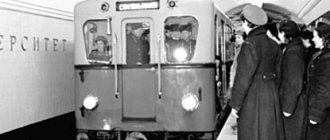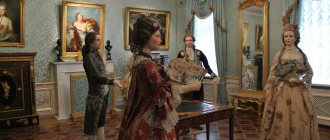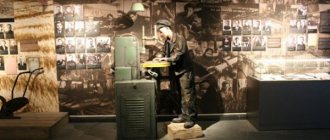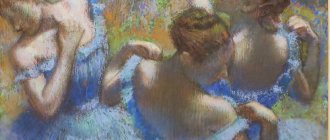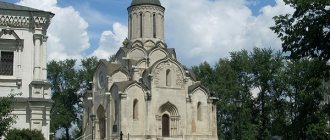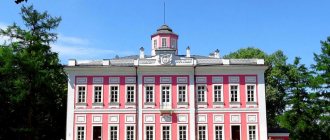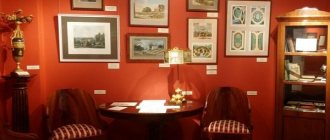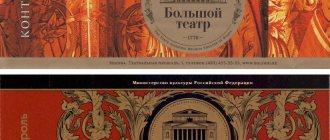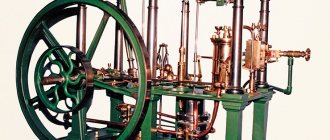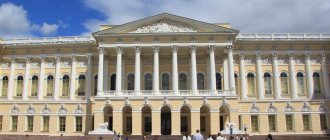How the museum was born
The idea to create a museum dedicated to revolutionaries appeared in the spring of 1917. The February Revolution had just taken place in Russia, and journalist Vladimir Pavlovich Kranichfeld proposed opening a new museum in Moscow. The decision was made, however, the matter did not go further than the creation of the Society for the organization of the future museum.
The Civil War began in Russia, followed by a period of hunger and devastation. The country was forced to solve the most urgent problems, and the hands of a new museum simply did not get around to it. The matter got off the ground only in 1922. For the 5th anniversary of the revolution, the first exhibition with the loud name “Red Moscow” was organized in the city center.
A model of an armored car at the entrance to the museum from which V.I. spoke. Lenin in 1917
Two years later, a museum was created, and the former revolutionary and historian Sergei Ivanovich Mitskevich became its director. Museum exhibitions consisted of materials from two exhibitions - “History of the Party” and “Red Moscow”.
Story
In March 1917, the famous journalist and Russian literary critic Vladimir Pavlovich Kranichfeld took the initiative to create a Museum of the Revolution in the capital. Initially, it was supposed to be dedicated to the February Revolution of 2021 and the overthrow of monarchical power in Russia. The first exhibition “Red Moscow” opened its doors to visitors in 1922. In 1924, the State Museum of the USSR Revolution was founded. Its first director was a statesman, professor, publicist Sergei Ivanovich Mitskevich. The museum covered the historical events of the revolutionary liberation movement in modern Russia, starting from the 17th century and ending with the October Revolution.
Since 1927, in addition to exhibitions dedicated to the revolutionary movement in Russia, collections dedicated to the achievements of the new socialist society have appeared. By 1941, the museum's holdings numbered about 1 million items. During the Great Patriotic War, most of the exhibits of the Museum of the Revolution were evacuated. An exhibition dedicated to the heroic struggle of the Soviet people against the fascist invaders begins to work within the walls of the former English Club.
After 1950, the profile of the museum changed slightly. He begins to cover the historical moments of the Russian Social Democratic movement, three revolutions, and the history of the development of Soviet society. More than 30 thousand exhibits were transferred to the funds of other museums. In 1968, it became an institution with research status and also changed its name to the Central Museum of the USSR Revolution.
© Official group of the Museum of Contemporary History of Russia VKontakte
In the late 1980s, the general public was given access to more than 70 thousand documents in special storage. Since the 1990s, work has begun on modern exhibitions that cover the historical period, from the mid-19th century to the present. In 1998, the museum acquired its real name - the State Central Museum of Contemporary History of Russia.
In 2015, the first stage of a large-scale reconstruction of the Museum of Contemporary History of Russia was completed, which included recreating the original historical appearance of the building. The fence and façade of the building, as well as the famous sculptures of lions decorating the main entrance, have been restored.
Museum in the 20th century
The new museum revealed the essence of the revolutionary movement in the country starting from the 17th century. Here one could learn about the peasant wars led by Stepan Razin and Emelyan Pugachev, about the uprising in December 1825 and the work of revolutionary commoners. Separate sections were devoted to the civil war and three revolutions of the beginning of the last century.
Hall No. 17. USSR in the mid-1950s - early 1980s.
There are a lot of museum exhibits. They were brought by former participants in revolutionary organizations and their immediate relatives. Famous artists donated their paintings to the museum. For example, Ilya Repin donated several historical works and a picturesque portrait of Kerensky to the museum.
As the funds grew rapidly, the exhibition was expanded a few years later. In addition to the history of the revolutionary movement, she began to talk about the milestones in the construction of a socialist society. At the end of the 1930s, one million exhibits were already stored here. However, only some of them were exhibited in the halls. Most of the museum's relics were shown during historical exhibitions.
In the summer of 1941, when it became clear that fascist troops were rushing towards Moscow, the museum was evacuated. But the building was not empty. In the same month, it hosted an exhibition dedicated to the outbreak of the war. In the courtyard, in plain view, museum employees who remained in Moscow installed a downed German plane, mangled German guns, a damaged tank, a machine gun and mortars. Towards the end of the war, the exhibition began to be restored, and the main funds were returned to the capital.
In the 1960s, the Moscow Museum began to oversee museums of this type, which were opened one after another throughout the country. New topics appeared in the exhibition, revealing medicine, the education system and nature conservation in the USSR.
When perestroika began, many archives were declassified. The museum staff put on display over seventy thousand exhibits that ordinary visitors had not been able to see until that time. Then they held several exhibitions highlighting various events taking place in the country.
Halls and exhibitions
The Moscow Museum of Contemporary History of Russia is a place of memory of the events that took place in the Russian Federation over the past 150 years: the abolition of serfdom, revolutionary upheavals, the collectivization process, the terrible war of 1941–1945, Gagarin’s grandiose flight, the times of perestroika and the activities of the country’s first presidents.
The main thing here is not sequence and chronology, but a living illustration of what was happening in the country.
Over the 100 years of activity of the museum, a gigantic collection has been collected - 1,300,000 exhibits. All this is located on three floors, there is a hall for lectures and a buffet. Lectures and other forms of classes are regularly held for Moscow schoolchildren and those simply interested in history. But the main task of the museum is to cover the political history of Russia.
The museum's exposition is located in 26 halls; the minimum time to get acquainted with its exhibits is about 1–2 hours.
The initial exhibition tells about the Russian autocracy and serfdom. Documents from the time of Alexander III tell about the famous peasant reform, about changes in the military and judicial systems, and in local government.
There is a huge layer of materials dedicated to the heroic feat of the legendary cruiser “Varyag” and the courageous defenders of Port Arthur during the Russian-Japanese War. In the courtyard there is a visible exhibit from afar - a trolleybus that did not surrender to the protesters during the putsch.
You can also see the original armored car from which Lenin called to the people, and many other equally interesting evidence of the past.
Much space and time is devoted to famous personalities who made a great contribution to the destinies of nations. Their thoughts and real deeds are illuminated by diary entries, correspondence, and archives of participants in revolutionary movements of different years - populists, anarchists, Mensheviks, Bolsheviks, putschists, etc.
Personal belongings of politicians (for example, Stalin) and expensive items presented to them by foreign delegations are also kept for posterity.
A large crowd of spectators gathers near a collection of posters from the USSR era. From the Civil War to perestroika, posters accompanied Soviet citizens, fulfilling the mission of emotional advertising of socially significant acts. Some of them are unique - they are preserved in one copy.
The exhibits highlighting the events of military history are very interestingly selected. These are real battle flags, awards, badges, and service weapons. Under each item there is a sign with a thorough explanation.
The halls are equipped with modern museum multimedia equipment. There are volunteer consultants who organize excursions for guests. In one of the halls there is a robot guide that independently conducts a half-hour excursion.
The exhibition is constantly updated with new materials. Time does not stand still, and the collection of museum exhibits is accordingly growing.
Museum today
The museum is housed in a beautiful building built at the end of the 18th century. From 1831 to 1917, the classic mansion housed the English Club.
The museum rooms are decorated by theme. In addition to documents and old photographs, they display badges, orders and medals, old postcards, banners, rare books and posters. The real decorations of the exhibition are porcelain, ceramics, graphic works, paintings, collections of domestic and foreign lacquer miniatures and antique furniture.
In the first hall, visitors get acquainted with the changes that Russia experienced after the abolition of serfdom. The agricultural country was moving onto an industrial footing. Over the last two decades of the 19th century, the railway network in Russia doubled, and heavy industry grew sevenfold. Moving from hall to hall, tourists can learn about the foreign policy of the Russian Empire at the turn of the 19th-20th centuries, revolutionary events, the civil war, how the crisis of the Soviet system grew, and perestroika took place.
The spacious Fireplace Hall of the English Club is of great interest. It is decorated with snow-white columns of the Corinthian order and a painted ceiling. On the walls hang paintings representing the main milestones in the history of Russia. They were painted by famous artists Konstantin Yuon, Kuzma Petrov-Vodkin, Martiros Saryan, Pyotr Konchalovsky, Ilya Mashkov and Boris Kustodiev.
Visitors linger for a long time in room No. 16, where gifts given to the leaders of the Soviet state are exhibited. These are objects of art, rare weapons, richly decorated national costumes, ceramics and jewelry brought from 40 countries. Since the museum is dedicated to the modern history of the country, several halls tell about the events that took place in Russia at the beginning of the 21st century, as well as about the symbols of the country.
Reviews about the Museum of Contemporary Russian History and exhibitions
The museum's exposition is located in 26 halls; according to visitors' reviews, the minimum time to get acquainted with its exhibits is about 1–2 hours. The halls are equipped with modern museum multimedia equipment. There are volunteer consultants who organize excursions for guests. In one of the halls there is a robot guide that independently conducts a half-hour excursion. Visitors note the beautiful architecture of the museum building, which in itself is a significant attraction.
Exhibition halls on the official website of the Museum of Contemporary History of Russia
The museum's exhibitions reflect such important historical moments as social movements in the Russian Empire, the modernization of the economy at the end of the 19th century, the social and political life of Russia and the Soviet Union, the foreign policy of the Russian Empire, the Russo-Japanese War of 1904–1905, the development of culture and science in Russia, the Great Patriotic War. It also shows life in the USSR during various periods of its existence, Perestroika in 1985–1991, Russia at the beginning of the 21st century.
Some reviews emphasize the excessive coverage of the achievements of Soviet Russia, the fact that little attention is paid to wars and negative moments in the country's history. The inconvenient captions for many items on display, which greatly obscure the exhibits themselves, are emphasized. In general, positive impressions of visiting the museum are noted. The most popular exhibitions are “100th anniversary of the Komsomol”, “History of the Russian Empire”, and “Perestroika of the 1990s”. Many guests speak positively about the museum’s souvenir kiosk, where you can purchase interesting items as a souvenir of your visit.
© Official group of the Museum of Contemporary History of Russia VKontakte
Exhibitions and educational programs
For many years now, museum staff and historians have been publishing the Living History magazine. Its publications are dedicated to prominent historical figures and the history of the state. Since 2021, the museum has been holding a large exhibition dedicated to the centenary of the revolution. On it you can see rare sound recordings, films, photographs and things from a hundred years ago.
There is a lecture hall for everyone, where historians and art critics speak. The topics of the lectures vary. Stories about the manuscripts of A.S. are especially popular among visitors. Pushkin, unrealized projects of the Moscow metro and persecution of the church during the USSR.
Useful information for visitors
The museum is open to guests on Tuesdays and Thursdays through Sundays from 11:00 to 19:00, and on Wednesdays from 12:00 to 21:00. Monday is a day off. Please note that the ticket office closes half an hour earlier. A ticket for an adult costs 250 rubles, and for children – 100 rubles (2018). Children under 16 years of age are admitted to the museum free of charge. Photo and video shooting are paid separately.
Fireplace room of the English Club
Tourists can view the exhibition independently or with a guide. Sightseeing and thematic excursions are held throughout the halls: “My country is Russia” and “Russia in the 21st century”. For lovers of Russian history, the museum hosts the CLIO club.
